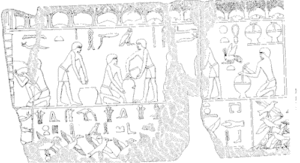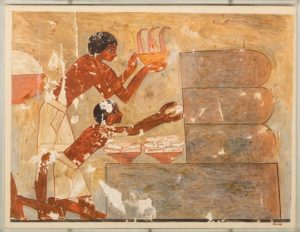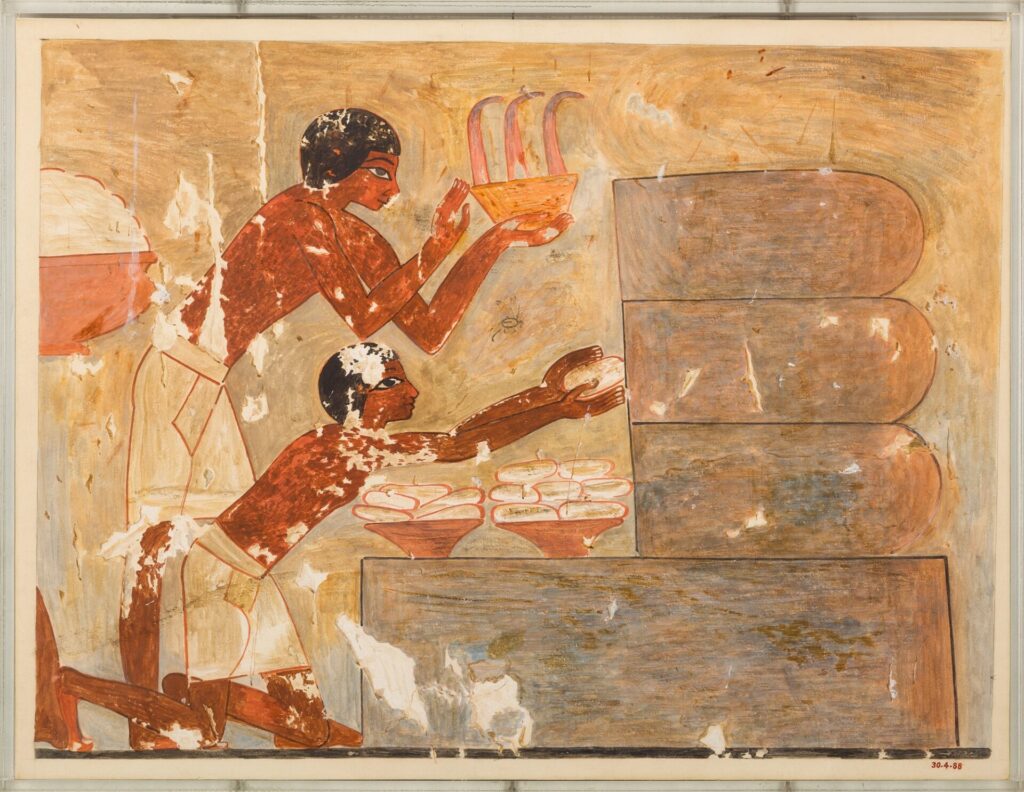Wild bees, and honey a beginning.
A cave in southern Spain carries a simple image depicted on a wall. At first glance it might seem difficult to work out what is occurring. The picture is of a figure collecting honey and given the bees swarming around, he or she is certainly working hard for it. The image dates to approximately 8,0000 BC and the cave (the Arana or Spider cave) is a UNESCO World Heritage site.

The figure from the cave art
It’s certainly a first and points to what must have been an obvious practice, honey gatherers making use of a highly valuable foodstuff. Turn the clocks forward a four and a half millennia or so and switch to the other side of the Mediterranean and we come across a very different image, also involving bees and people. This time the location is Egypt, more accurately the Sun Temple of Niuserre, which dates to around 2,500 BC. The image found here involving bees is different. It’s not a lone person collecting wild honey, this is apiculture.

Honey being stored – (picture from here)
Apiculture was important to the Egyptians, ‘Sealer of the Honey’ and ‘Overseer of Beekeepers’ were titles given to officials who were responsible for overseeing the hives and production of honey. Honey was a valuable commodity, it played a role in religious rites and sacred animals were fed honey cakes. It was used in medicine, the Smith Papyrus (circa 2,600 BC) mentioned honey as a salve for wounds. In a more bizarre fashion it was used as an ingredient, alongside crocodile dung, as a contraceptive.
It was even a prize of war, Thutmose III who reigned in the 15th century BC, extracted it as tribute from his lands in Palestine.
Before going any further it’s worth considering another image (below), this time dating to the end of the 15th century BC and from the Tomb of Rekhmire.

Two figures are featured; the one standing is blowing smoke from a bowl whilst the one below collects honeycombs. The hives are large cylinders, stacked horizontally on top of each other and with a removable end (allowing one of the pair to remove the honey). The other end would have a small hole for the bees to enter and exit.. This was an ingenious design and layouts of hives found later suggest that these were stacked in aisles with the removable end facing inwards. In this way a worker in that aisle had access to the removable lid of the hives either side of them.
One of the many rivals to Egypt were the Hittites, who had their capital in the centre of modern day Turkey but whose borders ran south into the Levant.
The important thing to understand about the Hittites was that they were serious about honey and bees. Really serious. Hittite oaths involved honeycomb and clay tablets found at Boghaz-kevi which dated to 1300 BC revealed a number of laws. Among these were fines for stealing hives, bees or even damaging hives. Not only did they codify their love of apiculture legally they also displayed it in their language. The Hittite word for honey ‘mil-it‘ and the word for sweet milittu are similar enough to suggest one may have been formed from the other.
As with the nature of any empire the Hittite Kingdom started to unravel. By the 10th century BC the lands to the south and along the coast were left to whoever picked up the mantle of kingship. Though bee keeping isn’t mentioned in the Bible (the word ‘honey’ is never used within the context of apiculture) it’s unlikely it was absent in the lands the Bible mentions.
Bees as a trading commodity?
An excavation in the Jordan Valley at Tel Rehov revealed a developed understanding and application of apiculture. The remains of hives (similar to the cylinder designs) dated to the 10th century BC, roughly the time of King David. The apiary was located in a built up area of the settlement, a surprise given the nature of the local subspecies of bee which is quite aggressive.
One suggestion was that these hives were highly valued and located here as they could be more easily guarded. A chance discovery within the remains gave a very different possibility.
Stuck inside a fragment of one of the hives were parts of an insect, more precisely parts of a bee. These were examined and the results confirmed it wasn’t one of the local sub-species, it was a sub-species native to Anatolia (modern day Turkey). This was no accident; the ‘Anatolian’ bee was far less aggressive and had a higher honey yield. Suddenly the notion of keeping a number of hives in a residential area seems less of a problem.
The fact the hives were situated where they may also reveal a more practical element, it wasn’t just protecting the honey and the hives from damage or theft. The beekeepers could also manage the colony better. Hives placed in a built up area might have kept them away from the local bee population and prevent any cross breeding or attacks. In terms of numbers, there are estimates of the hives at this site which reach close to 200. The hives measured 80cm in length and had a diameter of 40cm, it has been estimated that each hive could support a colony of circa 10,000 bees and provide 3-5 kg of honey each year (as well as 0.5-0.7kg of beeswax). This site could theoretically have provided 300-500kg of honey each year.
This was an industrial level of output.

The hives from Tel-Rehov, the arrow points to the bee entrance (image source here)
The evidence that bees could be imported across borders purely for their yield has implications. It points to a nuanced and developed form of apiculture. It might also indicate that there was a wider practice of this with trading routes supplying preferred species to increase yields.
In the 8th century BC we have evidence of apiculture being something a ruler boasted about. Shamash-res-usur ruled over the Mesopotamian lands of Mari and Suhu and claimed that he had introduced bee keeping here. The use of honey was well known in this region so it’s likely that this boast related specifically to apiculture as an industry.
From a simple image in Spain to selective breeding in the Jordan Valley, the concept of apiculture had, pun intended, truly blossomed. The Egyptians had started the ball rolling with the bee as something more than a provider of honey and in the next section we’ll look at how Greece and Rome approached apiculture, focusing on as much the practical as the abstract.



